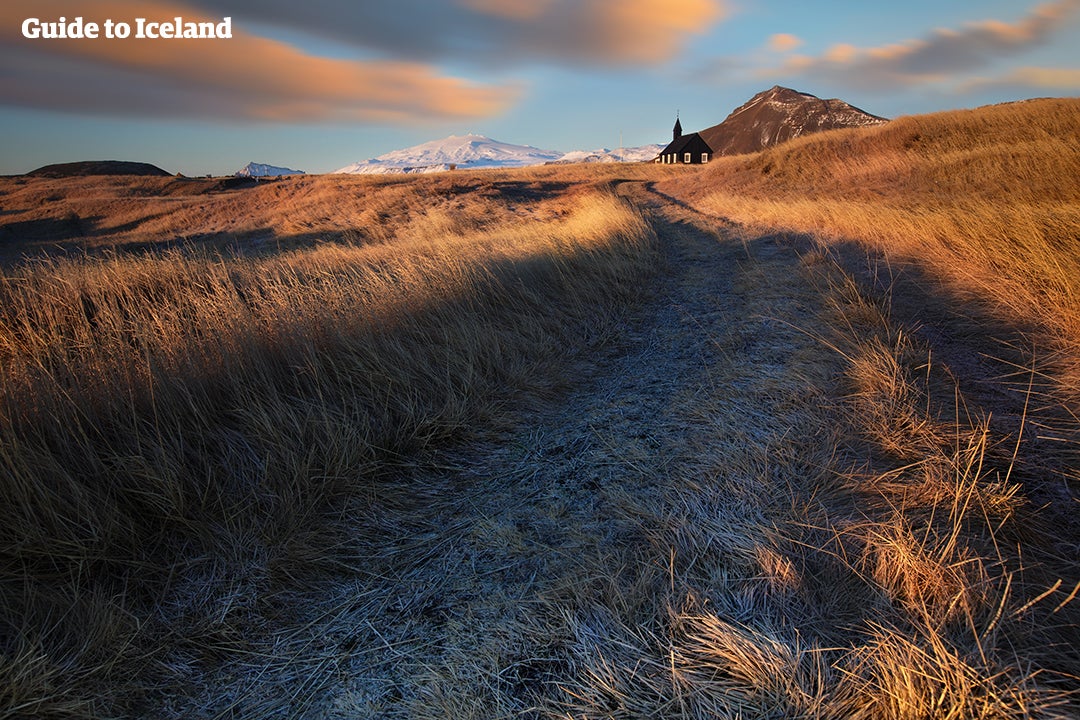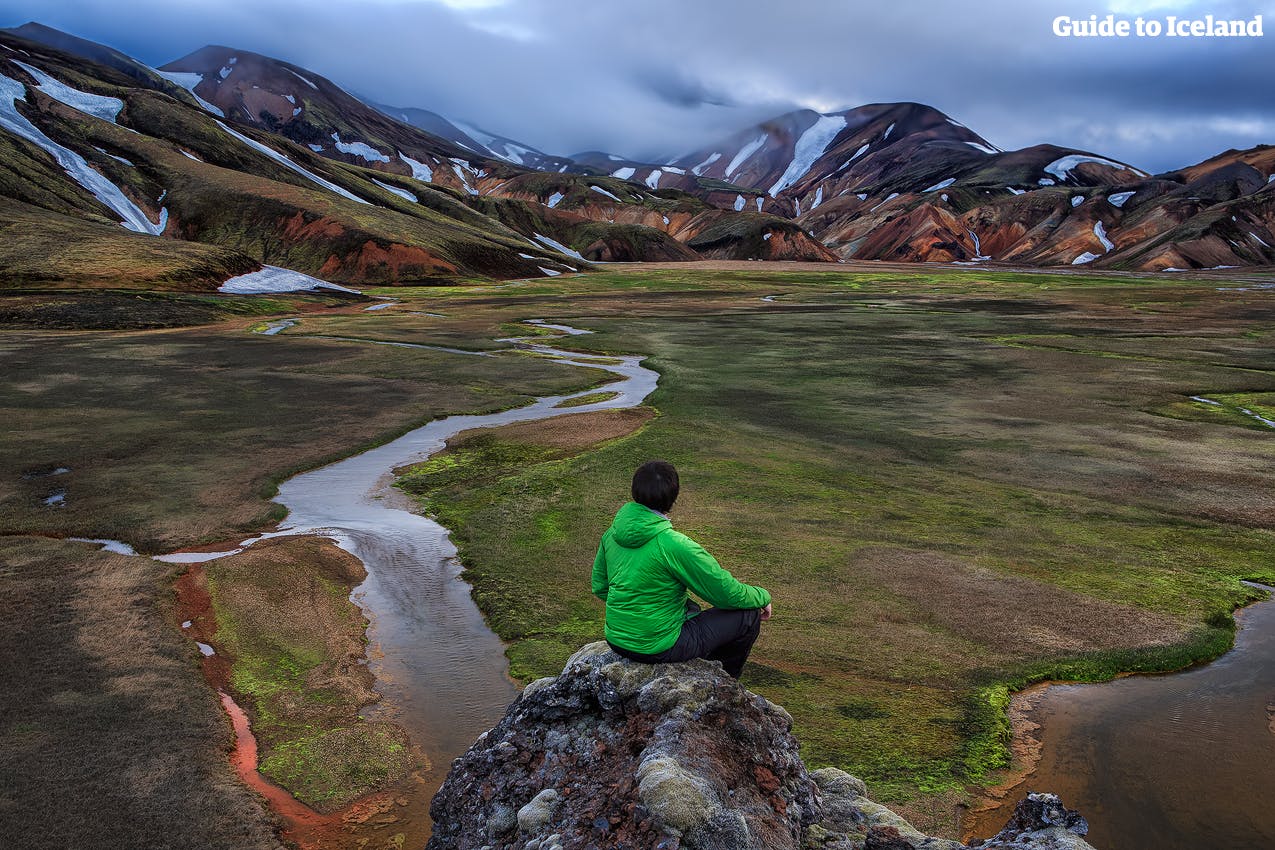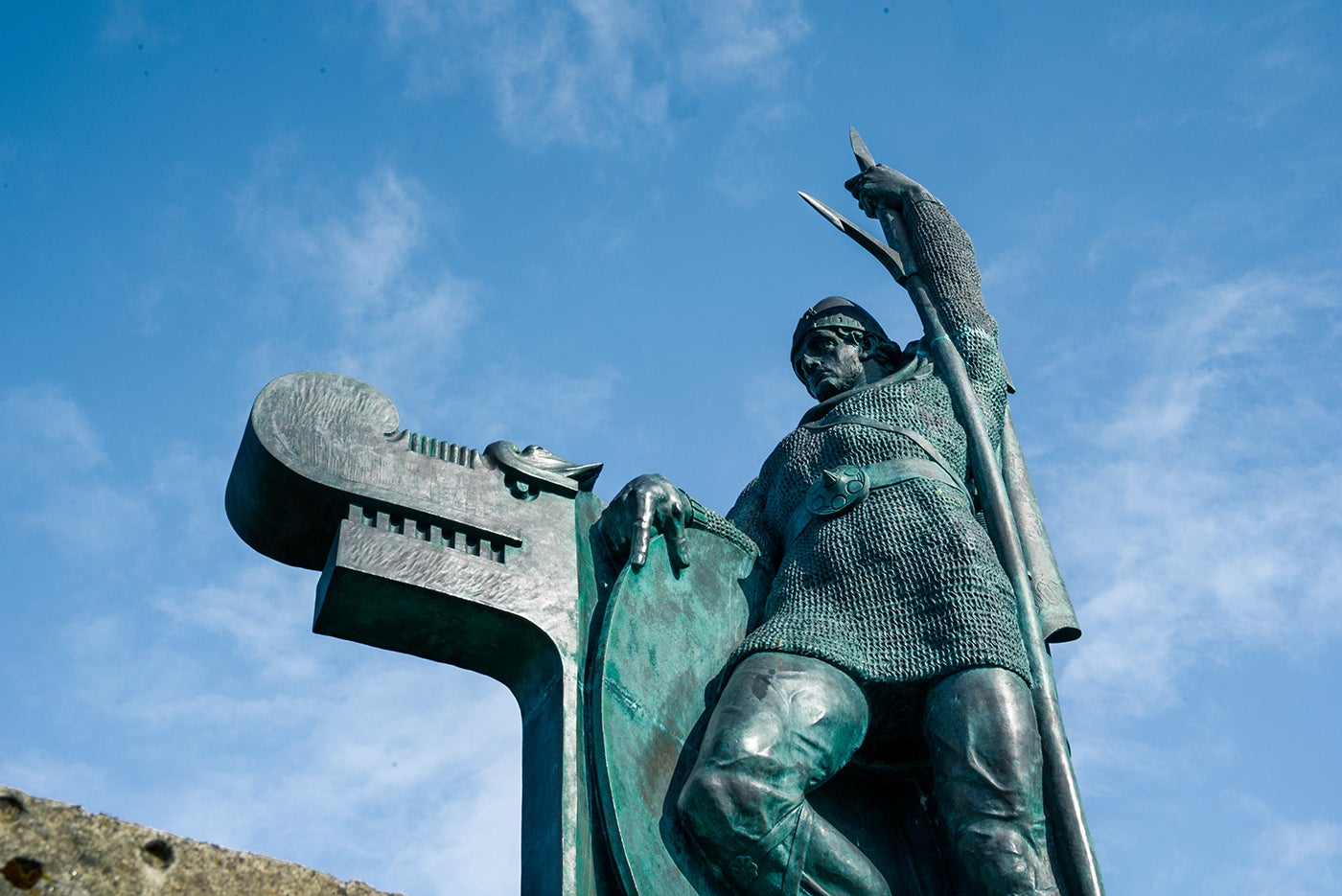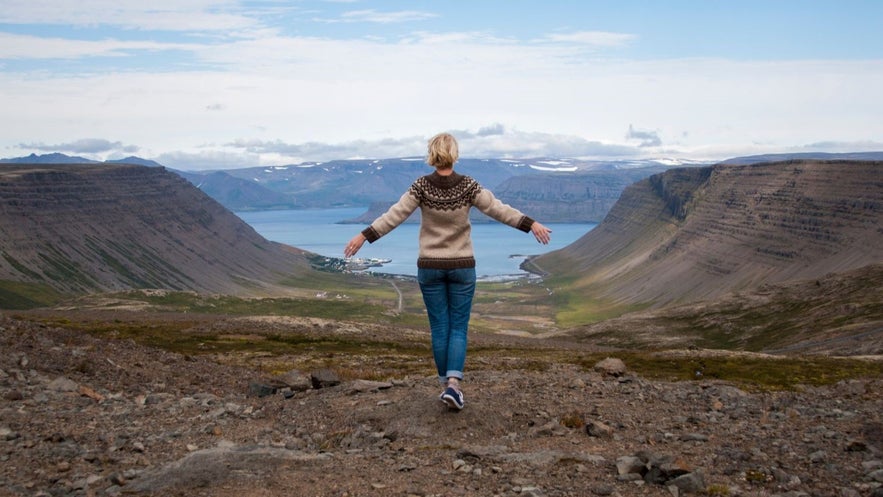
The lopapeysa sweater is a prominent symbol of Iceland and the perfect way to keep warm when exploring the country. Learn about the iconic traditional Icelandic sweater, the unique Icelandic wool, and Icelanders' love for knitting.
The most iconic piece of Icelandic wool clothing is undoubtedly the lopapeysa. If you're traveling with a rental car in Iceland or staying in one of the many cozy accommodations around the country, picking up a lopapeysa is one of the best souvenirs you can get.
The name simply means an unspun-wool sweater: "lopi" refers to a type of unspun wool, and "peysa" is the Icelandic word for a sweater.
Why You Can Trust Our Content
Guide to Iceland is the most trusted travel platform in Iceland, helping millions of visitors each year. All our content is written and reviewed by local experts who are deeply familiar with Iceland. You can count on us for accurate, up-to-date, and trustworthy travel advice.
Icelanders have a long, rich history when it comes to wool clothing and knitting, and it’s no surprise, as wearing wool is ideal for cold and changeable weather. Lopapeysa has also become a symbol of Icelandic culture on the international stage, and it’s a garment you’ll likely use while you’re here and long after your trip ends.
Read on for everything you need to know about this famous Icelandic sweater, a “must-buy” on your trip to Iceland.
Key Takeaways
-
While the lopapeysa is a modern cultural symbol of Iceland, the country has a long tradition of wool-working and knitting.
-
The authentic Icelandic sweater has a protected designation of origin and must meet strict requirements to be called “lopapeysa.”
-
You have plenty of choices when it comes to buying a lopapeysa in Reykjavik or around Iceland. You may even knit your own!
-
Lopapeysa is extremely popular among Icelanders, worn with pride to national celebrations and festivals, and often given as a cherished gift. It’s one of the best souvenirs to bring home from Iceland.
- Plan your trip with Iceland in Winter - The Ultimate Travel Guide
History of the Lopapeysa Sweater
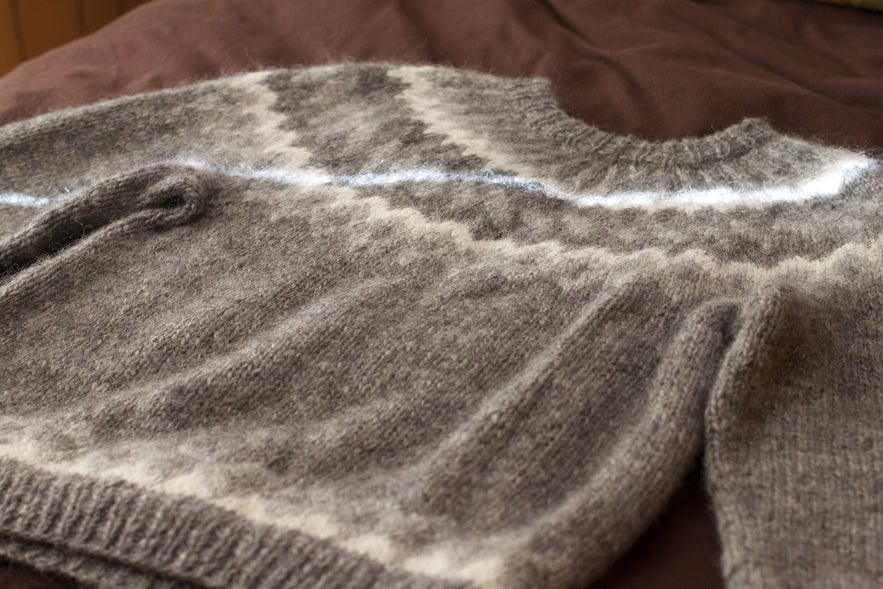
Photo from Wikimedia, Creative Commons, by cogdogblog. No edits made.
Knitting came to Iceland at the start of the 16th century, likely with foreign merchants. Before then, Icelanders practiced a craft known as nalbinding or knotless knitting, a method found all over Northern Europe, which is referred to as “vattarsaumur” in Icelandic. Creating clothing with this method took a long time.
When knitting came to Iceland, people quickly adapted to the practice, as it was much quicker than knotless knitting. The resulting material also had the benefit of being stretchier than items made from nalbinding.
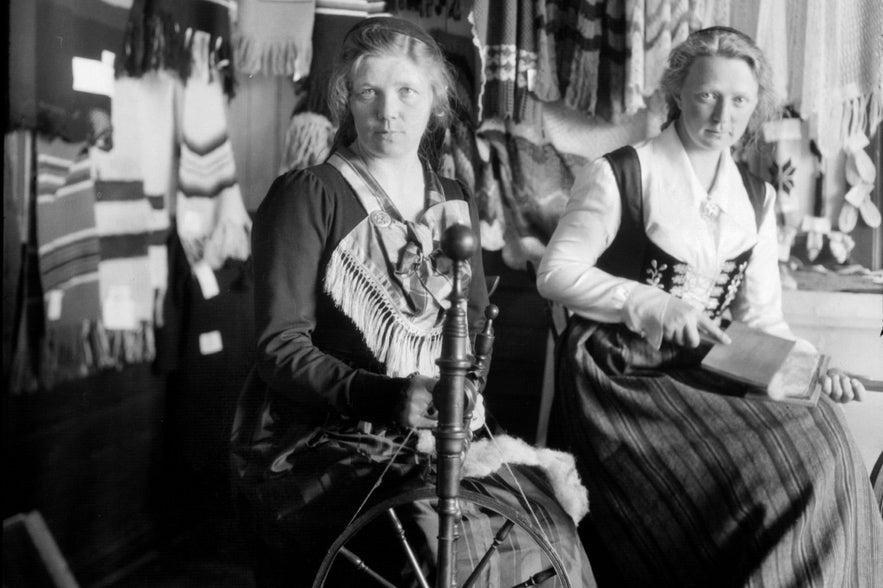
Photo from Wikimedia, Creative Commons by Magnús Ólafsson. Photo taken in 1911 of women showcasing traditional wool work at a Handcraft Exhibition.
Through the centuries, wool was generally spun into yarn before being knitted, which was very time-consuming.
In the early 20th century, people moved into larger towns from the countryside, leaving rural farms with fewer workers. To save time and make the most out of limited resources, people started working with unspun wool, known as lopi.
Sweaters made from lopi were mostly used as men's workwear, serving sailors especially well, but their popularity quickly grew among all Icelanders.
The design of these sweaters was influenced by foreign patterns from countries like Norway, the Faroe Islands, Greenland, and more. With time, however, Icelandic sweaters have gained their own identity.
The lopapeysa, as it's known today, came to be around the 1940s and 1950s as many women started knitting at home and selling for export. At the time, women would get paid between 5 USD and 6 USD (675-900 ISK) for each sweater, which took two or three full days of work to complete.
This was a low salary, but it helped many households stay afloat.
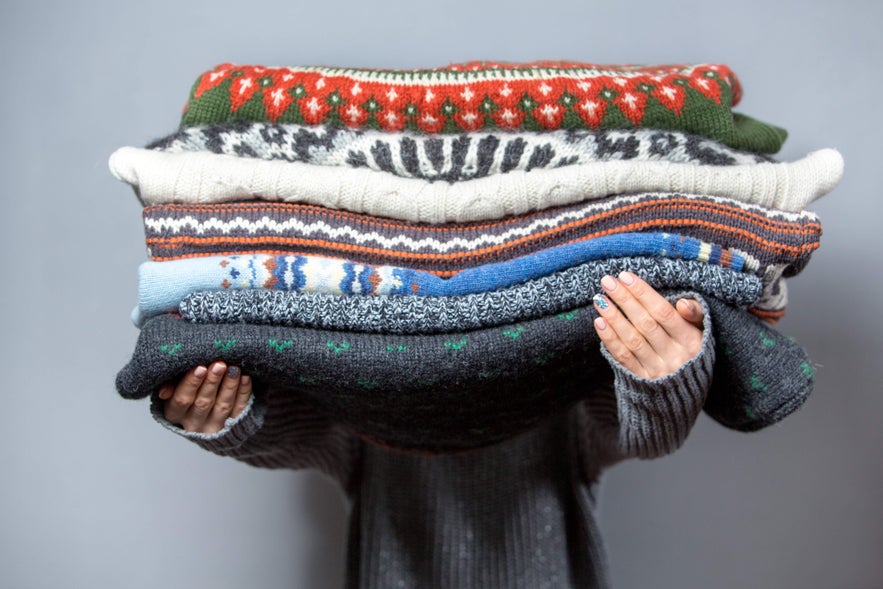 By the late 1960s, 40,000–60,000 sweaters were being exported annually, establishing the Icelandic lopapeysa as an international brand.
By the late 1960s, 40,000–60,000 sweaters were being exported annually, establishing the Icelandic lopapeysa as an international brand.
To support the work of artisans and fight for better pay, the Handknitting Association of Iceland was founded in 1977. In its first year, it gained over 1,200 members, and though that number is lower today, the association is still the main authority on the lopapeysa.
Some believe it was Auður Sveinsdóttir, the wife of Nobel-prize-winning author Halldór Laxness, who designed the first lopapeysa sweater. Auður was a great craftswoman and writer and was very influential in the development of this Icelandic icon.
Lopapeysa sweaters were common outerwear until the 1980s, when they started to lose popularity. The classic wool sweater had a resurgence among knitters in the late 1990s and regained public interest in the early 2000s as innovative designers took inspiration from the sweater for all kinds of outerwear.
A new type of lopapeysa exploded in popularity: short, tight-fitting, featuring a zipper in the front. This model led the way for the more diverse sweaters you can find today. Yet, the most important feature of the lopapeysa, its Icelandic wool, remains unchanged. Let’s explore this wonderful material in detail.
The Icelandic Sheep and Icelandic Wool
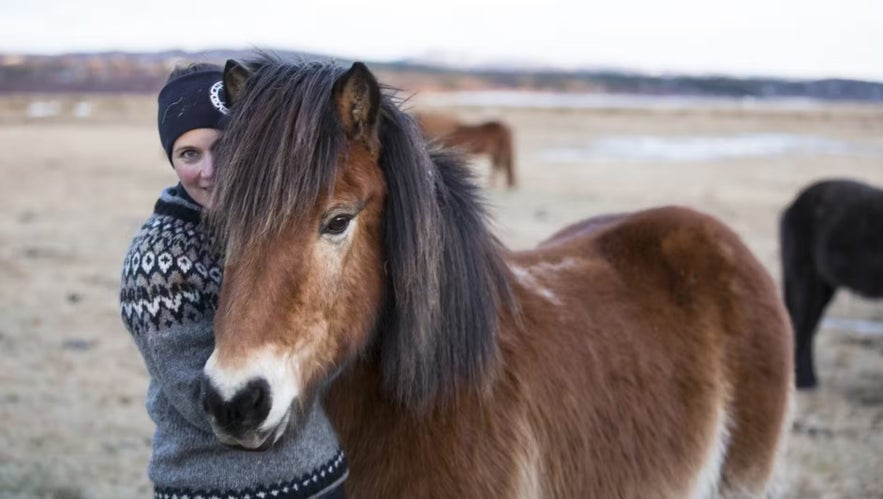
Iceland famously has some unique animal breeds, such as the Icelandic horse and the Icelandic sheepdog. The Icelandic sheep are worth adding to this star lineup.
They were brought to the island at the time of settlement between 870 and 930 A.D. They have been isolated since, adapting to Iceland's harsh environment over centuries. There are 400,000–500,000 sheep in Iceland, many more than human inhabitants.
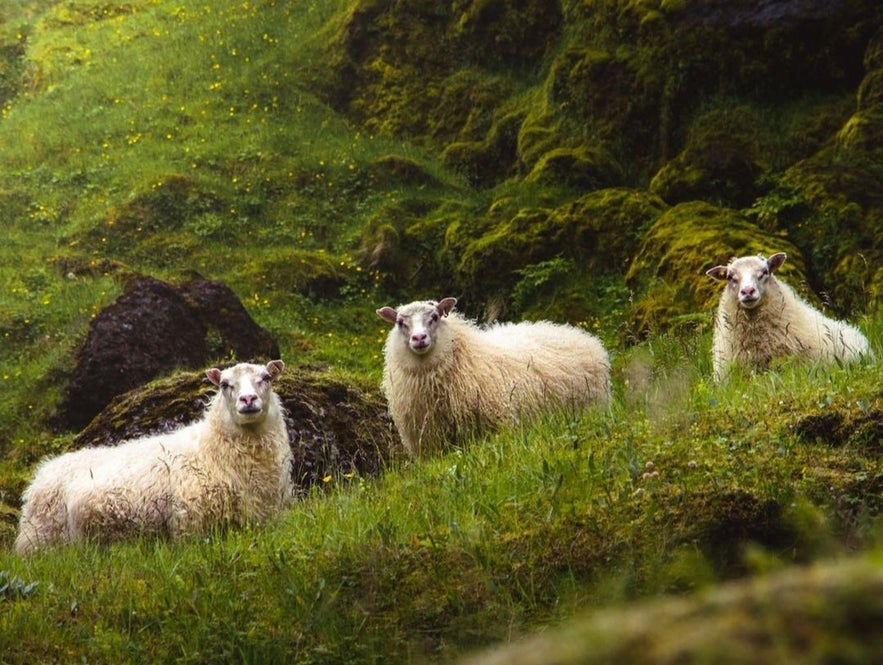 Icelandic sheep enjoy great freedom in the summer, roaming free around the wilderness during the warmer months. In the fall, they're rounded up and returned home during an event known as "rettir" to shelter them for the winter.
Icelandic sheep enjoy great freedom in the summer, roaming free around the wilderness during the warmer months. In the fall, they're rounded up and returned home during an event known as "rettir" to shelter them for the winter.
Apart from their wool, Icelandic sheep are also celebrated for their meat, which is tender, flavorful, and lean, owing to the sheep's natural grazing habits. It's a staple of Icelandic food culture, and in 2023, it received a protected designation of origin from the European Union, highlighting its uniqueness.
Icelandic Wool
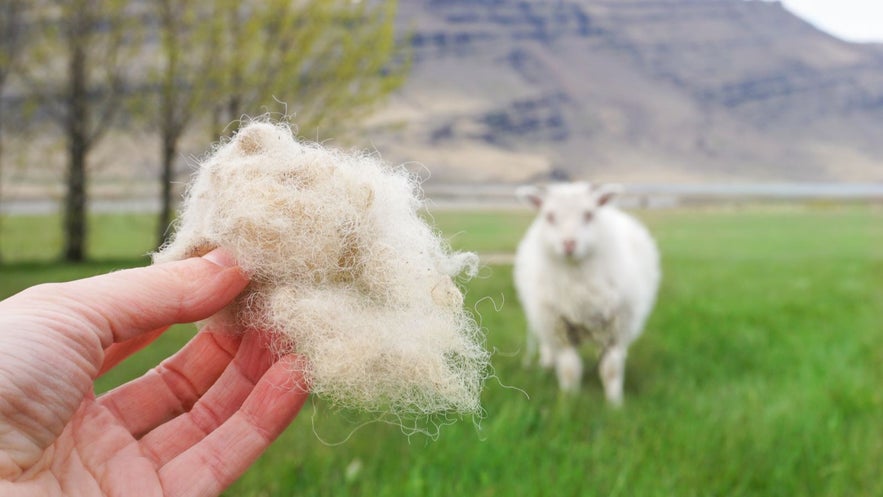 Icelandic sheep wool is renowned for its durability, warmth, and water-resistant properties. This wool retains its natural oils, known as lanolin, offering exceptional insulation against cold and wet conditions.
Icelandic sheep wool is renowned for its durability, warmth, and water-resistant properties. This wool retains its natural oils, known as lanolin, offering exceptional insulation against cold and wet conditions.
The outer layer of the wool, known as "tog", is composed of coarse, water-resistant fibers, while the inner layer, "thel," consists of finer, insulating fibers. This dual-layer structure lets the wool keep its thermal properties when wet, which happens often in Iceland.
The combination of tog and thel wool makes Icelandic wool highly versatile for knitting. The tog provides structure and durability, while the thel adds softness and warmth.
The lopapeysa sweaters are made from lopi, an unspun Icelandic sheep wool.
Types of Lopi Wool
 You may encounter different kinds of lopi wool when shopping for a lopapeysa or another Icelandic wool product. The main difference is how the wool is worked, resulting in different qualities and uses:
You may encounter different kinds of lopi wool when shopping for a lopapeysa or another Icelandic wool product. The main difference is how the wool is worked, resulting in different qualities and uses:
-
Alafosslopi: One of the most common forms of lopi, known for its chunkiness and warmth. It is ideal for warm, light items like sweaters and blankets. It's great for a lopapeysa sweater.
-
Lettlopi: This is a lighter version of Alafosslopi, suitable for garments that require warmth but are not too bulky. It’s often used for autumn sweaters, hats, and lighter outdoor clothing, balancing comfort and warmth.
-
Joklalopi: The name translates to "glacier lopi." This type is even chunkier than Alafosslopi. It's very warm, and garments made from Joklalopi are typically used for heavy-duty outdoor activities.
-
Einband: This lopi is very lightweight and much thinner than other variants. Einband is used for shawls, lace patterns, and lightweight sweaters. It offers the same warmth and water resistance but is more delicate.
-
Hosuband: This lopi is softer and smoother than other types. It's combined with nylon for added strength, and is suitable for socks and hosiery as it's more comfortable for skin contact in tighter garments.
-
Plotulopi: This wool is unique because it's a fully unspun wool, usually sold in flat disks called "plates." It's light and soft, but can be tricky to work with; but it is perfect for those who wish to customize the thread's thickness to suit their specific project.
The Icelandic Lopapeysa Sweater
 The most prominent feature of the traditional sweater is the circular yoke pattern, a decorative ring of visual elements around the neckline and shoulders. It's generally accentuated by contrasting colors. The sweater may also include smaller patterns on the cuffs and hem.
The most prominent feature of the traditional sweater is the circular yoke pattern, a decorative ring of visual elements around the neckline and shoulders. It's generally accentuated by contrasting colors. The sweater may also include smaller patterns on the cuffs and hem.
The fit features drop shoulders as the sleeves are attached slightly lower on the body. This gives a relaxed and casual look, allowing for ease of movement.
A classic Icelandic sweater is closed in the front, but you can find open ones with buttons or a zipper. These lopapeysa are easy to put on and can be a great option for children's outfits. You also have a choice of a low or high neckline or even a hood.
The Patterns of Lopapeysa
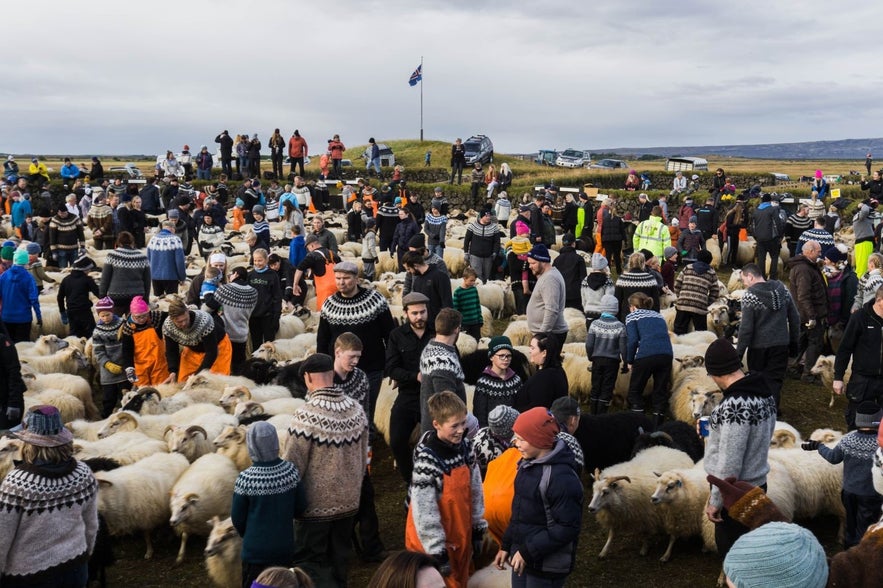
There really isn't a single "authentic" lopapeysa pattern. The patterns on the yoke can be very different. They usually have a theme inspired by nature, history, or culture. They're geometric and repeat all around the upper body, with multiple rows of different motifs stacked on top of each other. They also feature contrasting colors to the main body of the sweater.
There can be a lot of variety between sweaters, but some patterns have been popular through the decades. What many think of as a classic lopapeysa features triangle-like shapes along the top and bottom of the yoke with a black, white, gray, and brown color combination.
When it comes to the yoke patterns and colors, the rules leave a lot of room for interpretation. You can find real Icelandic wool sweaters that are colorful and bright or featuring Icelandic horses, sheepdogs, and even adorable puffins. It's also common to see flower motifs, like the historic "Attbladaros" or Eight Petal Rose, and other nature-inspired patterns.
What Makes a Lopapeysa Authentic?
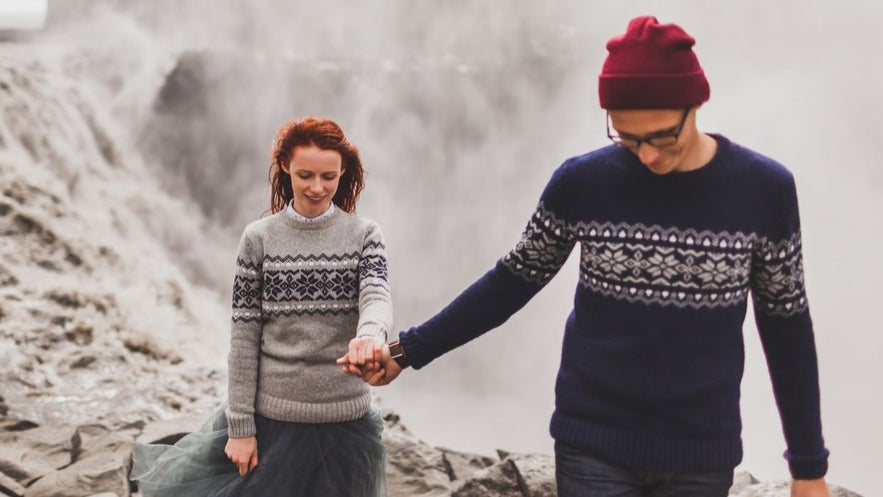
This lovely stock photo couple is wearing replicas of a lopapeysa. These sweaters are sewn together and likely not handmade or from pure lopi wool. The yoke pattern is also far too low on the body and goes around the upper arms. The photo was, however, marked as showing "traditional wool sweaters" in Iceland.
While in Iceland, you’ll find a lot of great outdoor wear inspired by the style of the lopapeysa. Generally, this is perfectly fine as long as the seller is not claiming that the product is authentic.
Beware of local stores labeling products as lopapeysa when they're not actually made in Iceland, are machine-knitted, or use the wrong material.
Since 2020, the lopapeysa sweater has had a protected designation of origin. For a garment to be a lopapeysa, the wool must be sheared from Icelandic sheep and must be new, not recycled. The sweater has to be hand-knit from Icelandic unspun wool, or "lopi," and be physically made in Iceland. There are also some specific design rules that it must follow.
Identifying an Authentic Lopapeysa

There are a few things to look for if you want to identify whether a lopapeysa is authentic.
First, check for any seams. An authentic sweater has none as it’s knitted in a way that does not require any sewing.
Second, check the label or ask the seller about the sweater’s origin. The seller should be able to tell you a bit about where the sweater came from. Some Icelandic pullovers are even labeled with the name of the knitter.
If there is a label (not all authentic lopapeysa have one), it will state “100% lopi” or “Icelandic wool” and indicate that it's handmade in Iceland. You can also feel the material. The lopi will feel rougher than the wool you may be used to.
Lastly, check the price tag. An authentic lopapeysa does not come cheap, and it requires the skill and time required for hand-knitting. If it sounds too good to be true, it probably is.
How Much Does an Authentic Lopapeysa Sweater Cost?
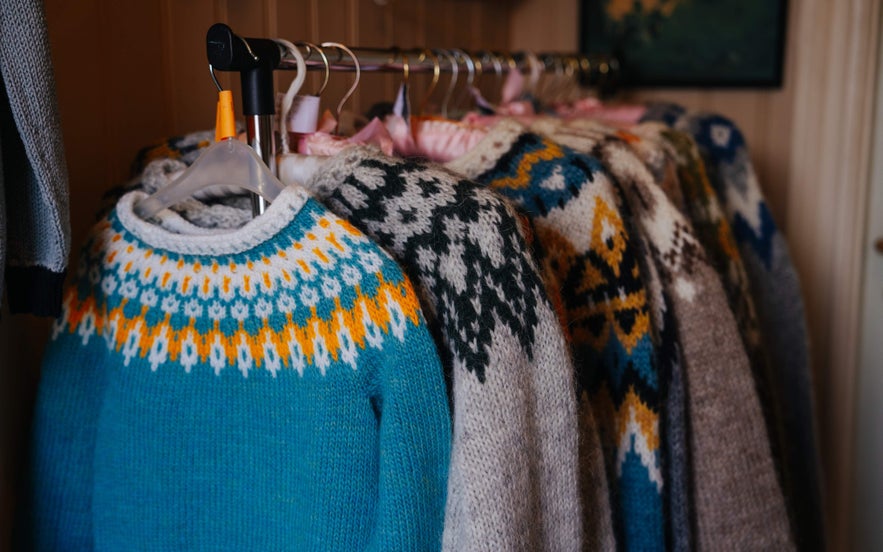 If you want a real lopapeysa sweater, it will be an investment. The average price range is 220–440 USD (around 30–60,000 ISK) and can go even higher, depending on how much work has gone into making the sweater.
If you want a real lopapeysa sweater, it will be an investment. The average price range is 220–440 USD (around 30–60,000 ISK) and can go even higher, depending on how much work has gone into making the sweater.
If you're buying a vintage lopapeysa sweater, you may find a more affordable option, but it won't be very cheap.
Keep in mind that you're not paying for fast fashion but someone's hard work, knowledge, skill, and time, along with the material cost of the sweater. Many passionate knitters also create their own patterns for the yoke, so you could be getting an original work of art.
How To Knit a Lopapeysa
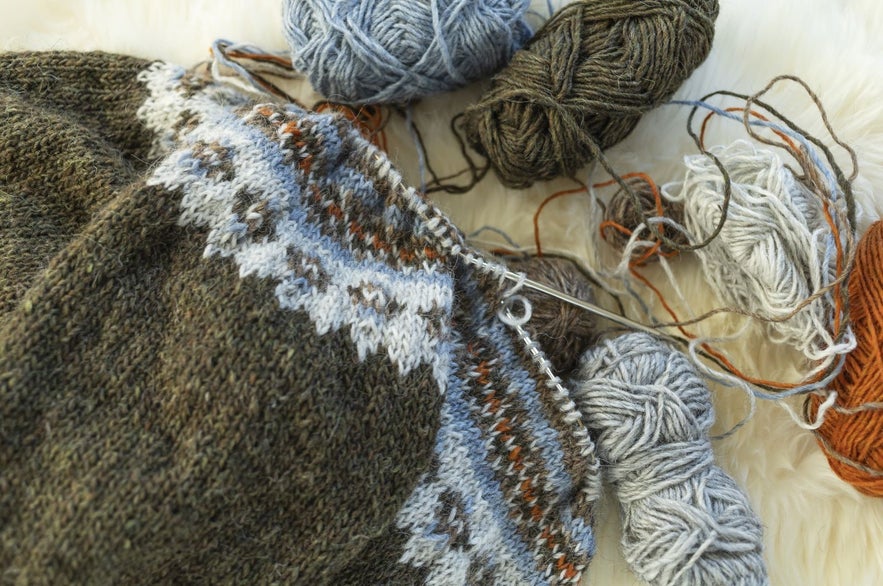 Want to knit your own? Why not? An authentic lopapeysa is hand-knit in Iceland, but if you follow a proper knitting pattern and use lopi wool, who’s to argue against you calling your project a lopapeysa?
Want to knit your own? Why not? An authentic lopapeysa is hand-knit in Iceland, but if you follow a proper knitting pattern and use lopi wool, who’s to argue against you calling your project a lopapeysa?
For your project, you'll need a large circular needle for the body and shorter circular needles for the sleeves. You can also use a set of double-pointed needles if you prefer. Needle size will vary by pattern.
A popular site for lopapeysa patterns is Lopi Design, where you can find knitting patterns in English, German, and French.
Once you've found your dream sweater pattern, it's time to buy the material. If you're starting your project in Iceland, check out local handcraft and yarn stores, as many sell lopi wool. If you’re starting the knitting before going to Iceland, check out Istex, where you can order a variety of authentic lopi wool.
If you're bringing your project with you when traveling to Iceland, make sure to store it in your checked luggage, as knitting needles may be confiscated by airport security.
If knitting your own sweater isn’t for you, read on to learn about the most reliable stores to find the finest lopapeysa in Iceland.
Best Places To Get an Authentic Lopapeysa Sweater
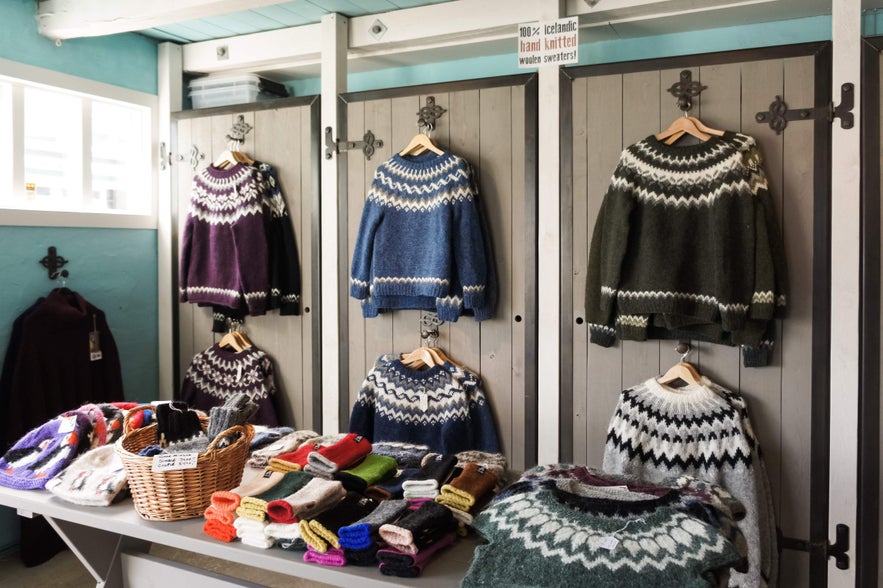 You can find Icelandic wool sweaters and accessories nationwide, but not all qualify as authentic lopapeysa. Here are the best locations to find your perfect sweater.
You can find Icelandic wool sweaters and accessories nationwide, but not all qualify as authentic lopapeysa. Here are the best locations to find your perfect sweater.
Where To Buy a Lopapeysa in Reykjavik
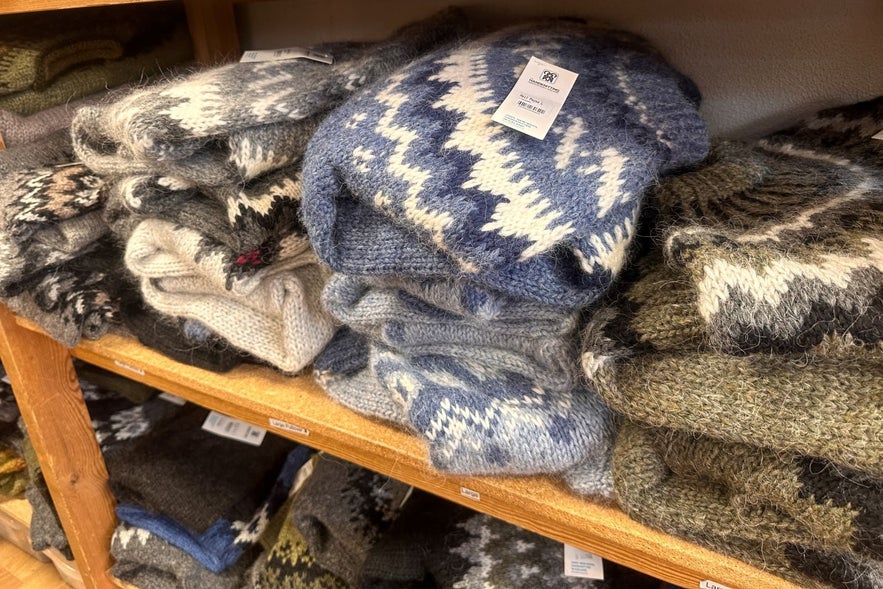 The best place to find an authentic lopapeysa is by visiting the Handknitting Association of Iceland, known as "Handprjonasambandid.” They are the main authority on traditional wool sweaters. The association is dedicated to knitting and selling locally handmade knitwear made from Icelandic wool.
The best place to find an authentic lopapeysa is by visiting the Handknitting Association of Iceland, known as "Handprjonasambandid.” They are the main authority on traditional wool sweaters. The association is dedicated to knitting and selling locally handmade knitwear made from Icelandic wool.
Their main location is on Skolavordustigur Street in the center of Reykjavik, where you'll also find the famous painted rainbow that leads to the Hallgrimskirkja Church. You can be sure that all of their lopapeysa sweaters are authentic.
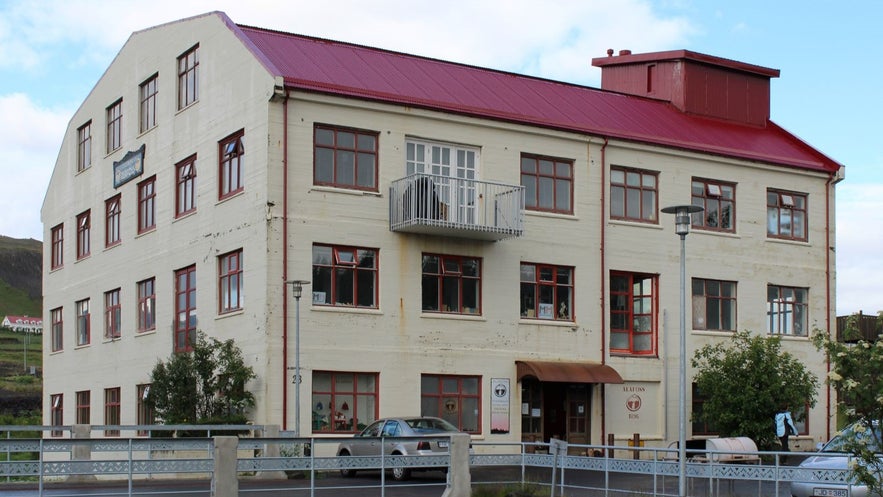
Another iconic location for authentic lopapeysa is Alafoss, the main producer of lopi wool in Iceland. They have been producing wool since 1896 with a store in the town of Mosfellsbaer, on the edge of the Capital Region. It’s a must-stop if you're in the area.
Alafoss is a great place to pick up lopi wool, and they also sell real wool sweaters. If you’re having difficulty finding the sweater of your dreams, you can custom order a tailor-made lopapeysa online for the perfect fit.
You may even be able to buy directly from the craftsman who made the sweater. A great place for this is the Kolaportid Flea Market by the Old Reykjavik Harbor, where you can get both new and vintage lopapeysa sweaters.
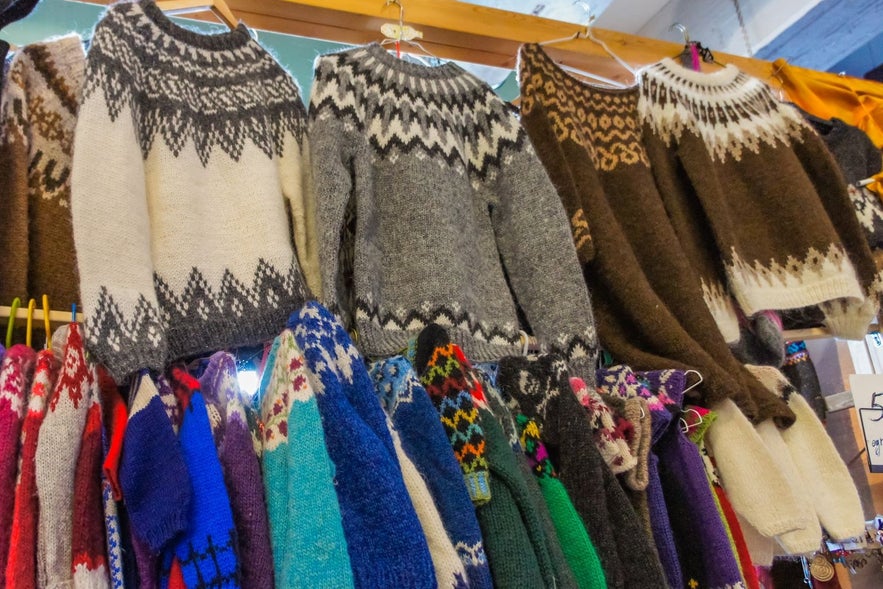
Note that the market is only open on the weekends, so account for that if you plan to visit. For another second-hand lopapeysa option, you can sometimes spot relatively affordable sweaters in Red Cross stores around Iceland.
Where To Buy a Lopapeysa Around Iceland
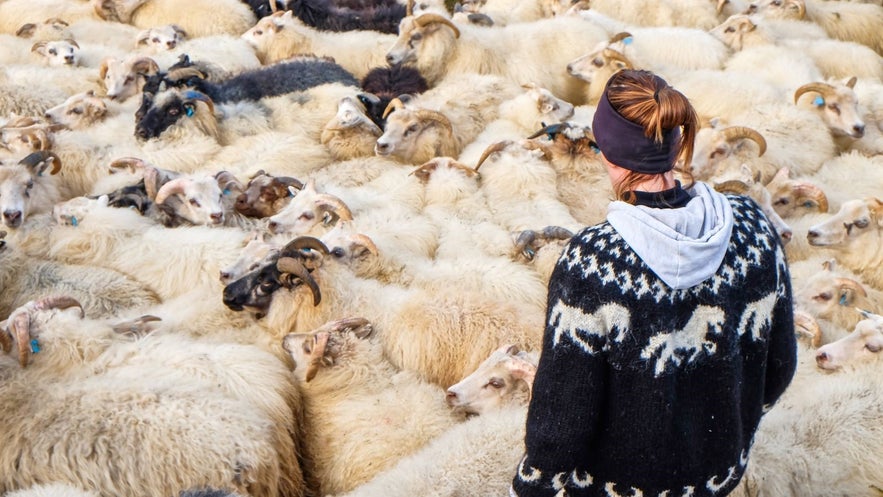 If you're planning to explore the countryside and don't have time to find a sweater in Reykjavik, don’t worry. No matter where your accommodation in Iceland is located, you can likely find shops that sell them nearby. Handcraft stores or small souvenir shops are your best bet.
If you're planning to explore the countryside and don't have time to find a sweater in Reykjavik, don’t worry. No matter where your accommodation in Iceland is located, you can likely find shops that sell them nearby. Handcraft stores or small souvenir shops are your best bet.
A great place to pick up a lopapeysa outside Reykjavik is the charming Una Local Product store, also known as "Sveitabudin Una." It's located in the town of Hvolsvollur on the South Coast, 67 miles (108 kilometers) southeast of Reykjavik and just a 20-minute drive from the famous Seljalandsfoss Waterfall.
Make sure to visit if you're planning to take tours of the South Coast, as you'll pass by on the way. It's one of the best places in Iceland for authentic art and handicrafts.
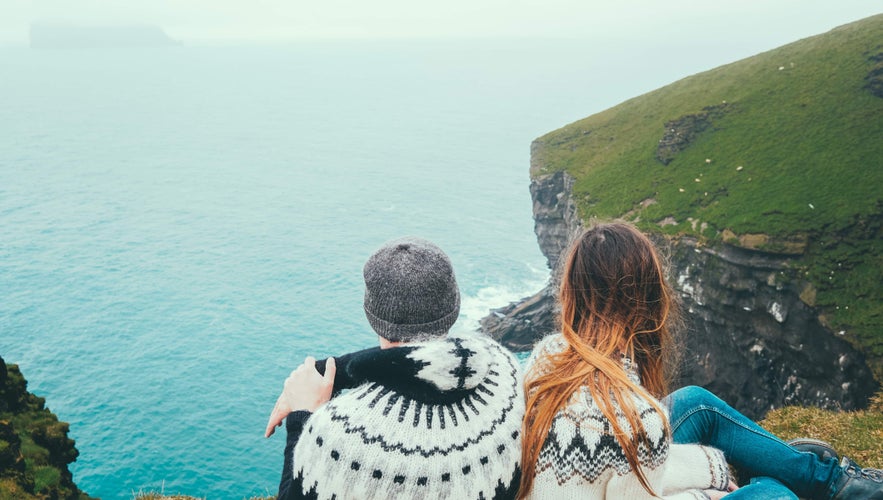 If you're traveling around West Iceland, you can stop by the Ullarselid Wool Center in the village of Hvanneyri. It's located in the picturesque Borgarfjordur Fjord, 42 miles (67 kilometers) north of Reykjavik and a 15-minute drive from Borgarnes, the main town in the region.
If you're traveling around West Iceland, you can stop by the Ullarselid Wool Center in the village of Hvanneyri. It's located in the picturesque Borgarfjordur Fjord, 42 miles (67 kilometers) north of Reykjavik and a 15-minute drive from Borgarnes, the main town in the region.
The Ullarselid Wool Center sells items crafted from Icelandic wool and other native materials, and you can find authentic lopapeysa sweaters made by passionate local knitters. You can also pick up some wool for your own projects.
Hvanneyri is known for its farming and is the location of the Agricultural University of Iceland. The area is surrounded by lush green fields and beautiful mountains, and you can find the Hraunfossar and Barnafoss Waterfalls, the historic Reykholt Village, and the Krauma Spa in the vicinity.
You can visit Borgarfjordur as a day trip from Reykjavik or include it in tours of the Snaefellsnes Peninsula. It can also be a good idea to stay in accommodations in Borgarnes, as the region is well worth exploring.
The Woolen Circle Route
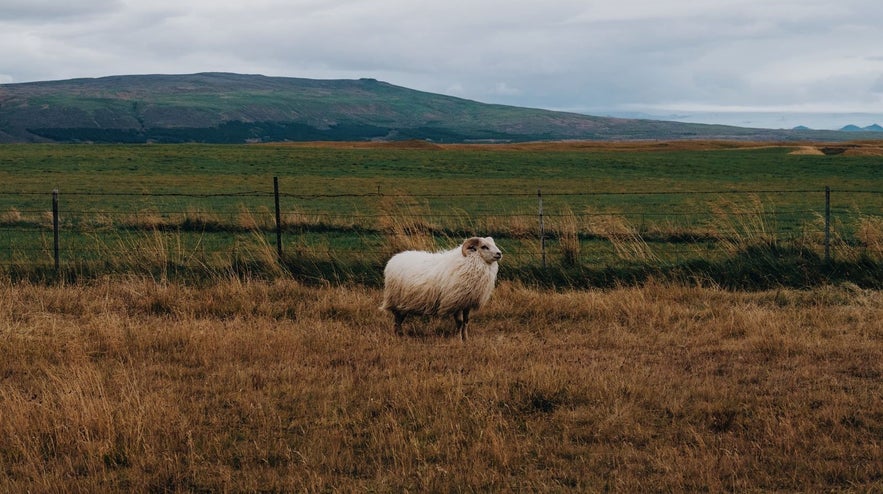 Those interested in the lopapeysa and the unique features of Icelandic wool shouldn’t miss the Woolen Circle Route. Connected to the renowned Golden Circle Route in South Iceland, it’s a great itinerary for buying your own lopapeysa.
Those interested in the lopapeysa and the unique features of Icelandic wool shouldn’t miss the Woolen Circle Route. Connected to the renowned Golden Circle Route in South Iceland, it’s a great itinerary for buying your own lopapeysa.
Tours of the Golden Circle include three main locations: Thingvellir National Park, Gullfoss Waterfall, and Geysir Geothermal Area. The Woolen Circle adds four locations to this journey:
-
The Hespa Plant Dye Studio, where you'll learn about the traditional dyeing process and how plants can be used to create all sorts of colors.
-
The Thingborg Wool Shop, where you can buy locally made lopapeysa and other wool knitwear.
-
The Uppspuni Mini Mill and Yarn Shop, which offer Icelandic yarn for sale and teach you about its production.
-
The Skalholt Historical Site, one of the most historically significant places in Iceland.
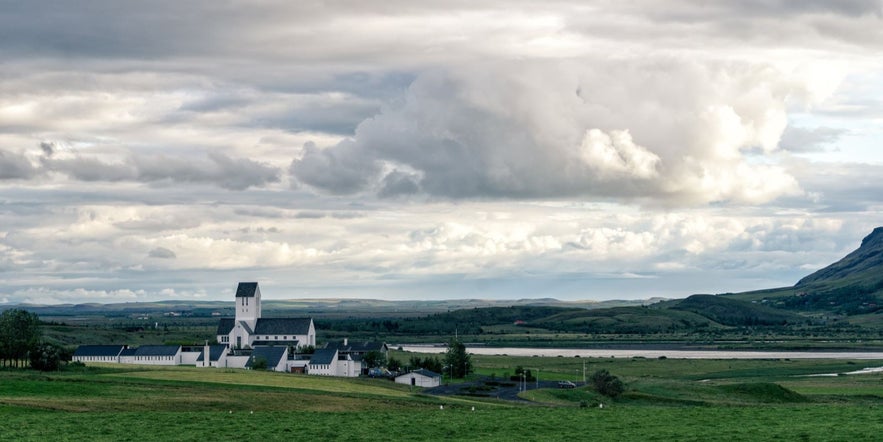 Established in the 11th century, Skalholt was one of Iceland's two Episcopal seats, along with Holar in Hjaltadalur, a focal point for Christianity and the de facto highest seat of power in Iceland for nearly 800 years. It also housed Iceland's first school and was instrumental in preserving Icelandic sagas and historical records.
Established in the 11th century, Skalholt was one of Iceland's two Episcopal seats, along with Holar in Hjaltadalur, a focal point for Christianity and the de facto highest seat of power in Iceland for nearly 800 years. It also housed Iceland's first school and was instrumental in preserving Icelandic sagas and historical records.
Today, you can explore the modern Skalholtskirkja Cathedral, built in the mid-20th century, along with some interesting 13th-century tunnels and an archeological site. You can also find many magnificent artifacts from Skalholt at the National Museum of Iceland.

Skalholt is 24 miles (38 kilometers) away from the Gullfoss Waterfall and the Geysir Geothermal Area and is a connection point for the Woolen Circle and the Golden Circle.
While you can complete both as a day trip from Reykjavik, we recommend spreading the journey over two days and spending a night in one of the accommodations in the Golden Circle or hotels in Selfoss.
The Popularity of the Lopapeysa Today
 Knitting is a very popular hobby among Icelanders, most commonly among older women. The craft serves as a way to socialize, as many are part of knitting and handcrafting groups, referred to as a "saumaklubbur" (sewing club).
Knitting is a very popular hobby among Icelanders, most commonly among older women. The craft serves as a way to socialize, as many are part of knitting and handcrafting groups, referred to as a "saumaklubbur" (sewing club).
While a fairly modern Icelandic icon, the sweater has become an integral part of the national expression of Icelanders. You'll find many wearing them during events that connect to the Icelandic culture.
You'll see the lopapeysa at outdoor festivals, the yearly sheep roundup known as "rettir," or when enjoying traditional food at a Thorrablot gathering. You may also spot some on June 17th, Iceland's Independence Day, if the weather is bad. The lopapeysa is also the perfect companion for camping or hiking.
The lopapeysa has a special place in the hearts of Icelanders, as they're often made with love by family members. They make for cherished gifts that can last a lifetime.
Wearing and Caring for Your Lopapeysa
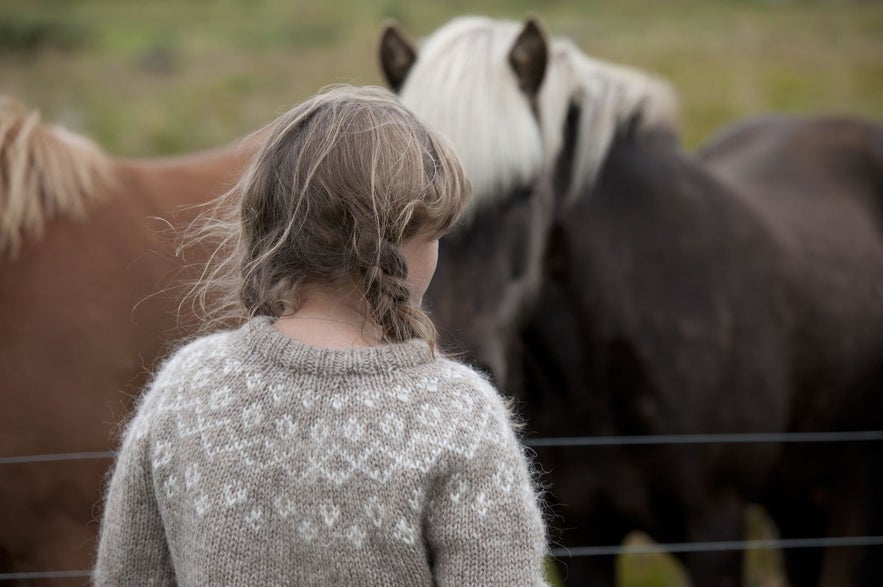 As a proud owner of this unique article of clothing, you might be wondering how best to style the lopapeysa and how to care for it so it can serve you well for years to come.
As a proud owner of this unique article of clothing, you might be wondering how best to style the lopapeysa and how to care for it so it can serve you well for years to come.
How To Wear a Lopapeysa Sweater
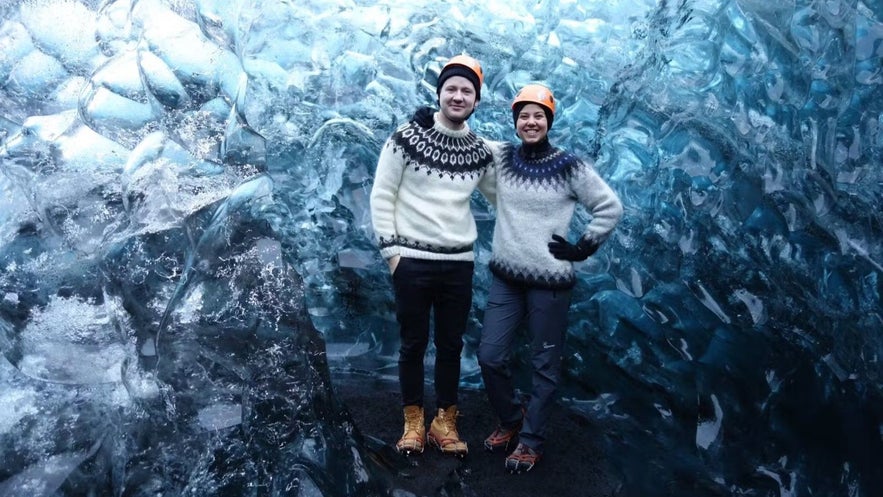 If you're not used to wearing Icelandic lopi wool, you may discover it’s very itchy if worn over bare skin. This is perfectly normal, as the wool used in authentic lopapeysa is coarser than common wool.
If you're not used to wearing Icelandic lopi wool, you may discover it’s very itchy if worn over bare skin. This is perfectly normal, as the wool used in authentic lopapeysa is coarser than common wool.
Although most lopapeysas soften naturally over time, some people may find new sweaters a bit itchy at first, even when worn over a t-shirt. A common local trick in Iceland is to apply a small amount of fabric softener to a clean cloth and gently stroke the inside of the sweater before wearing it. This helps relax the wool fibers without washing the garment, making it noticeably more comfortable against the skin while preserving its natural shape and lanolin.
The traditional Icelandic sweater is usually worn over an underlayer. A long-sleeve cotton T-shirt or a turtleneck is perfect, as it provides a soft barrier between you and the wool and lets you enjoy the full warmth of your sweater.
If you're visiting Iceland in winter and plan to try outdoor activities like glacier hiking, ice-caving, or snowmobiling, adding a light fleece layer under your lopapeysa is ideal for optimal warmth. Wear a windbreaker or parka as an outer layer to block out the elements, and you’re all set.
If this feels like too many layers, be assured that layering is key for unpredictable Icelandic weather. If you’re going on northern lights tours, you’ll be outside for long periods without much movement. Once you’re back indoors, removing a layer or two will help you stay comfortable and allow you to show off your lopapeysa.
- For more: What To Wear in Iceland: The Ultimate Guide for All Seasons
- See also: Northern Lights in Iceland - When & Where To See the Aurora
How To Clean a Lopapeysa Wool Sweater
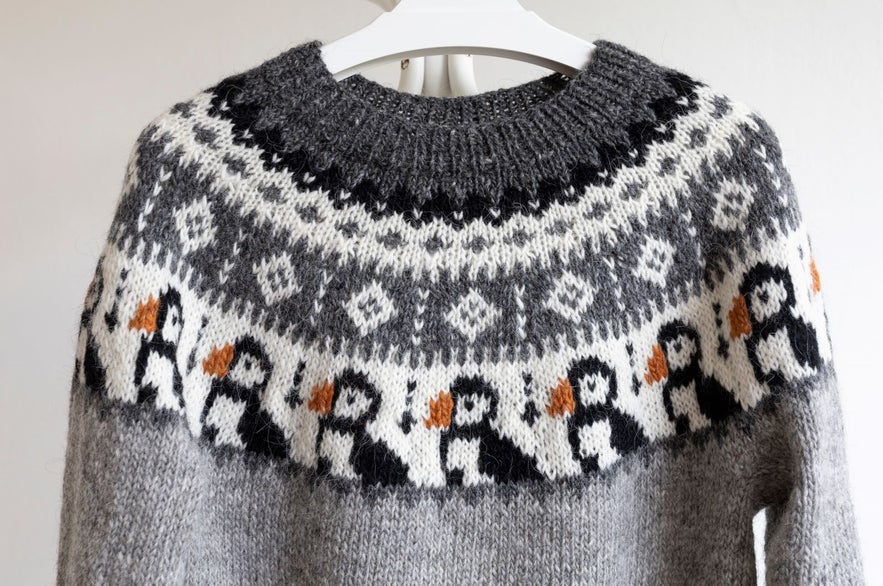
Proper care of a lopapeysa sweater is key to enjoying it for years to come. Icelandic wool rarely needs to be washed as it's usually not worn against the skin, but there may come a time when it needs some refreshing.
Hang your wool sweater outside to air it out. It's also better to store it folded rather than hung, as leaving it on a hanger may stretch the sweater over time.
If you want to deep clean your lopapeysa sweater, the best way is by hand washing in warm water using a soap specially formulated for wool. A good substitute is shampoo and hair conditioner, which may help soften the wool.
Gently submerge your wool sweater and soak for around 15 minutes. Gently squeeze out excess water, but don't wring it. It's best to press it in a towel to absorb excess moisture and then lay it flat to dry. If you hang dry, the weight of the water will stretch the material and change the fit.
If your sweater has a stain, spot-clean instead of cleaning the whole sweater. Gentleness is key, so make sure not to rub the material.
While we don't recommend it, you could also use a wool program on a washing machine. Choose the slowest spin setting and use wool soap with some hair conditioner. Lay flat to dry. Keep in mind that cleaning your sweater this way may damage it and result in pilling. Delicate sweaters should only be hand-washed.
Other Icelandic Wool Souvenirs
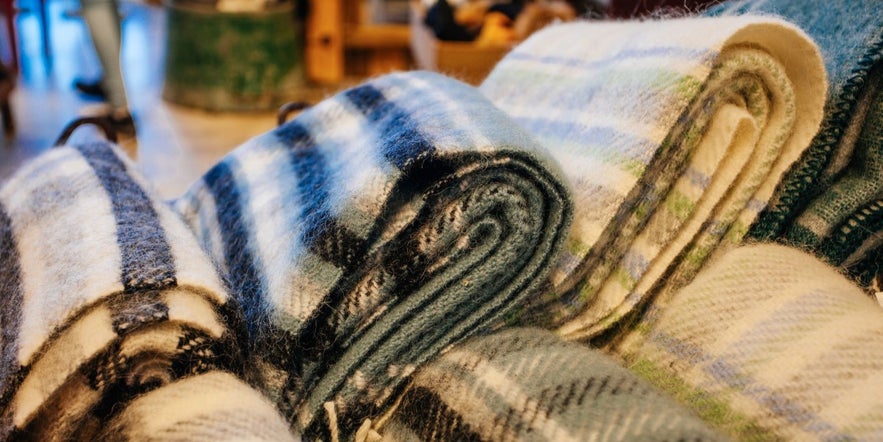
If you want some wool souvenirs but don't want to buy a lopapeysa sweater, there are other fantastic items. Wool socks, mittens, and hats are all excellent for winter weather. They're practical for your travels around Iceland and make for great souvenirs.
Don’t like wearing wool? Grab a luscious wool blanket if you have extra space in your luggage. Adorned with intricate patterns, traditional mittens also make a wonderful purchase, even for travelers who live in warmer climates.
You can create your own woolen souvenir at this skrimsli "wool monster" workshop. Especially fun as a family activity, the workshop will teach you about Icelandic folklore and guide you in the creation of your own adorable creature to take home.
The workshop takes place in the town of Gardabaer, just 6 miles (10 kilometers) from central Reykjavik, accessible by public bus.
Lopapeysa Sweaters and Icelandic Wool | Summary
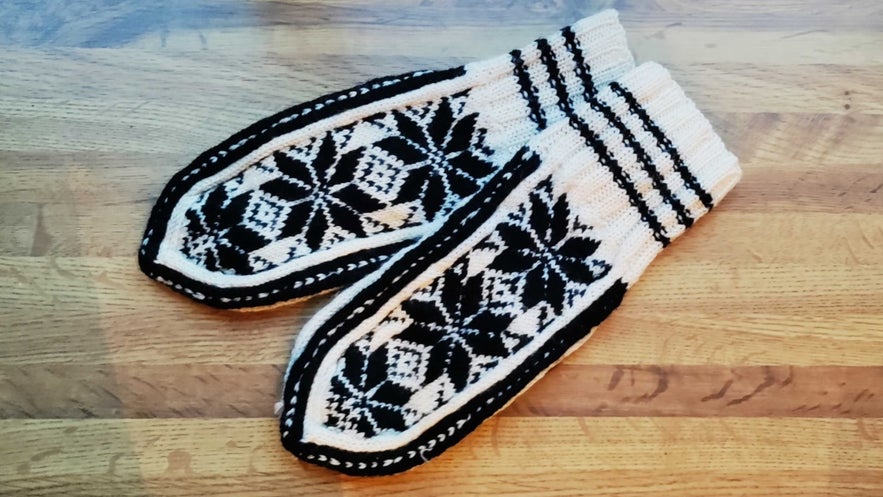
The Icelandic lopapeysa sweater is iconic, an unofficial national costume loved and revered by the locals. It makes for a thoughtful gift that can be purchased all over the island.
Made from Icelandic wool, the lopapeysa is warm and light, and is the best thing for layering during the colder months.
Its cultural significance, ties to Icelandic history, and practicality make the lopapeysa sweater one of the best things you can buy and wear during your trip to Iceland.
FAQs About Lopapeysa Sweaters
Below, we address a few more frequently asked questions about the lopapeysa.
Why doesn’t the lopapeysa have buttons or zippers?
Traditional designs are pullovers for better warmth and simplicity, but modern versions sometimes include fastenings for style and convenience.
How long does it take to knit a lopapeysa?
Depending on skill level, it can take anywhere from a few days to several weeks, as the circular yoke design requires careful pattern work.
Why are lopapeysa expensive?
Hand-knitted ones are crafted from high-quality Icelandic wool and take hours of skilled labor, making them a valuable artisanal product.
How can I tell if a lopapeysa is authentic?
Authentic ones are hand-knitted in Iceland from Icelandic wool and should include certification or come from reputable sources.
Do Icelanders wear lopapeysa daily?
While popular for outdoor activities and cozy wear in colder months, they are often worn casually or on special occasions.
Can lopapeysa be worn in the rain?
Yes, thanks to the natural water-resistant properties of Icelandic wool, but it’s not completely waterproof like synthetic materials.
Does the pattern on a lopapeysa have a meaning?
While some patterns are inspired by nature or Nordic traditions, most designs are chosen for aesthetics rather than specific symbolic meanings.
Are there different types of lopapeysa?
Variations exist in fit, color, and style, including modern adaptations with different yarn weights and cuts.
Do children in Iceland wear lopapeysa?
Many Icelandic children have them, as they are warm, durable, and practical for the country’s climate.
Are lopapeysa fashionable today?
Yes, they remain stylish in Iceland and beyond, often seen as a functional garment and a trendy statement piece.
Wrapped in Wool
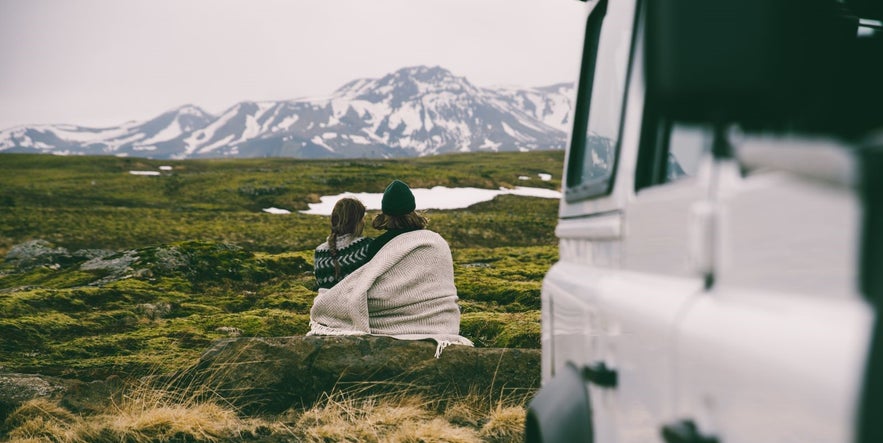
Owning a lopapeysa means embracing a piece of Icelandic culture. It’s a cozy, practical, and beautiful garment that tells a story of tradition, innovation, and the enduring bond between Icelanders and their land. When you wear a lopapeysa, you're not just staying warm; you're carrying a piece of Iceland with you.
Are you planning to buy an Icelandic lopapeysa sweater when you visit? What kind of sweater would you choose? Maybe you already own one. Share your thoughts on this icon in the comments below!


